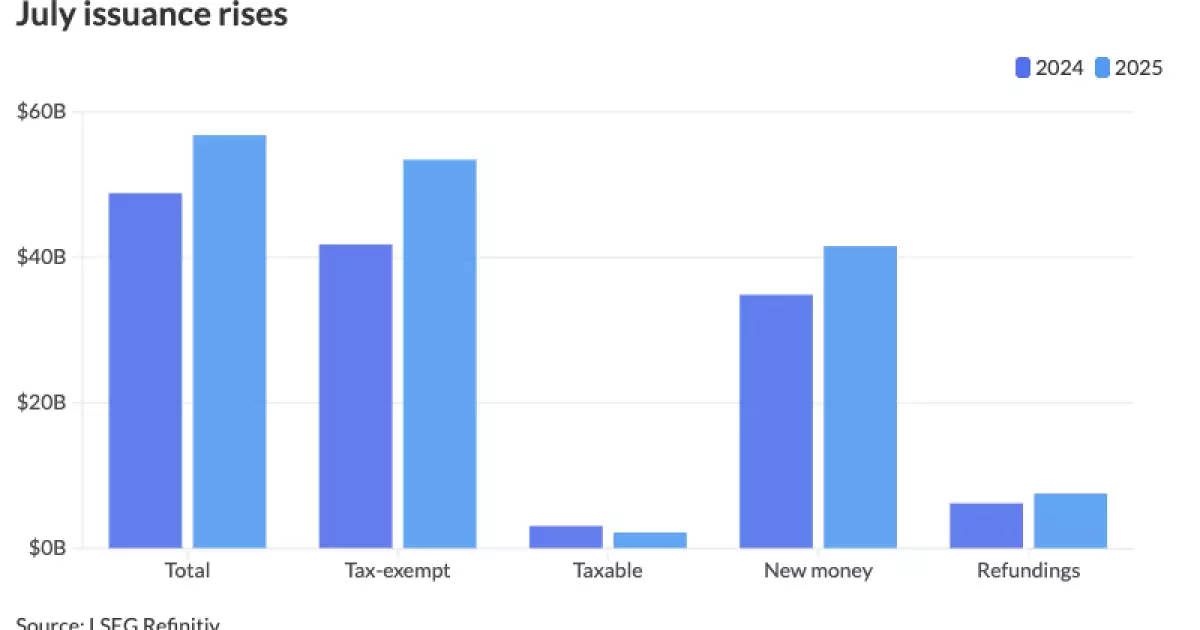The first half of 2025 has shattered historic records in municipal bond issuance, with the volume soaring to over $280 billion—an increase of roughly 14.3% compared to the previous year. Such a relentless push to tap into the capital markets reveals a deeply strategic movement by issuers, largely driven by fears of policy shifts, tax policy changes, and market volatility. While seemingly a sign of economic optimism and confidence, this relentless borrowing spree warrants skepticism. It may be a classic case of market overreach, driven more by panic and preventive tactics than genuine economic needs. Issuers are frontloading debt issuance to lock in terms before potential policy changes diminish the tax advantages that have historically fueled municipal markets. The question then becomes: Are we witnessing a responsible adaptation to market conditions, or are these signs of a bubble in the making?
The substantial weekly volume—sometimes reaching nearly $20 billion—indicates that entities are eager to secure low-cost financing. But this aggressive issuance could be a double-edged sword. Historically, such flurries of borrowing, especially when driven by fears over policy volatility, tend to create an overleveraged system, vulnerable to sharp corrections if market sentiment turns sour. The volume increases could represent an ill-timed gamble, where issuers and investors alike are caught in a frenzy that ignores underlying economic fundamentals. Rushing through debt deals in a volatile environment might temporarily boost infrastructure or public service projects, but it also bakes in long-term risks that could burden taxpayers for years to come.
Market Perception: Fears, Fads, and the Illusion of Confidence
The surge coincides with what seems to be a near-constant stream of concerns surrounding potential changes to the tax-exempt status of municipal bonds. Clinging to the hope that current exemptions will remain intact, issuers appear to be deliberately accelerating issuance to preempt any legislative reforms. Yet, this is a precarious mindset. The reality of tax policy is inherently unpredictable, and planning based on the assumption that exemptions are secure may prove to be a flawed strategy. What’s more worrying is that this overreliance on political stability could mask deteriorating fundamentals. If history is any guide, these surges in issuance do not typically translate into sustained economic growth but rather a reaction to perceived threats.
The narrative of stability is further compromised by the growing involvement of elite universities in the debt market. Far from being a sign of stability, this increased borrowing among top-tier educational institutions underscores a broader trend: that even the most financially sound entities find it necessary to seek unprecedented levels of debt amid a climate of uncertain policy and volatile markets. If universities, often seen as trusted entities, are borrowing aggressively, it suggests underlying worries about future funding and research budgets, exacerbated by political swings. Such external borrowing, driven by necessity or fear, tends to distort the actual economic health of these institutions and signals potential vulnerabilities lurking beneath the surface.
The Implications for Market Stability and Fiscal Responsibility
The higher-than-anticipated issuance forecasts from major financial institutions underscore a sense of optimism—or perhaps material complacency—about the sustainability of this borrowing spree. Predictions are now estimating total issuance to reach $600 billion in 2025, with some firms revising their estimates upward multiple times within just a few months. This revisionary tendency reveals a dangerous complacency among market participants who might be overlooking the risks that come with inflated debt levels.
The current environment positions municipal bonds as a relatively attractive investment owing to the higher yield environment, which offers 30 to 40 basis points of additional income monthly. However, such yields, while appealing in a low-growth global economy, may not be sustainable if the underlying economic growth does not keep pace with the debt accumulated. The risk is that the markets could react violently if investors begin to see signs of overborrowing—rising defaults, plunging bond prices, or sudden shifts in fiscal policy.
Meanwhile, states like California and Texas dominate issuance figures, raising questions about regional debt sustainability. California’s $45.58 billion in issuance, for instance, will inevitably come with long-term repayment obligations that could strain state budgets, especially if growth slows or interest rates climb. The push for more debt in a climate of rising rates hints at a future where taxpayers could shoulder unforeseen burdens, especially if the current borrowing binge is not matched by commensurate economic growth.
Long-term Risks: A House on Debt Foundations?
By embracing aggressive issuance now, policymakers and financial leaders risk creating a fragile foundation for future fiscal stability. History suggests that periods of frenetic borrowing often precede financial corrections, as overleveraged markets tend to be the first to tumble when sentiment sours. The political landscape, characterized by election cycles and policy uncertainty, only amplifies this risk. The belief that the current debt bubble can be sustained indefinitely is flawed—what we may be witnessing is a moment of overconfidence that will ultimately lead to fiscal strain.
This relentless quest for capital, fueled by fears of policy changes and market volatility, reflects a fundamental misjudgment of market resilience. Investors and public officials alike must critically evaluate whether this dependence on debt is a sign of strength or a ticking time bomb. As rates are expected to stay higher for longer, the ability to service this mountain of debt becomes increasingly questionable, further increasing the risk of a fiscal crisis that could ripple across local and national economies.
While the current municipal bond market appears robust, it’s crucial to recognize the warning signs of an overheating system. Increased issuance driven by fear and speculation could well mark the beginning of deeper vulnerabilities, especially if the underlying economic fundamentals fail to catch up with the debt levels accumulated during this frenzy. Market participants and policymakers must look beyond the surface and consider whether this spending spree benefits long-term stability or merely postpones inevitable fiscal reckoning.

